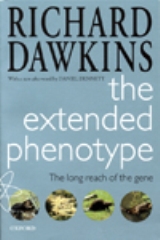
The Extended Phenotype
Encyclopedia

Richard Dawkins
Clinton Richard Dawkins, FRS, FRSL , known as Richard Dawkins, is a British ethologist, evolutionary biologist and author...
in a 1982 book with the same title. The main idea is that phenotype
Phenotype
A phenotype is an organism's observable characteristics or traits: such as its morphology, development, biochemical or physiological properties, behavior, and products of behavior...
should not be limited to biological processes such as protein biosynthesis
Protein biosynthesis
Protein biosynthesis is the process in which cells build or manufacture proteins. The term is sometimes used to refer only to protein translation but more often it refers to a multi-step process, beginning with amino acid synthesis and transcription of nuclear DNA into messenger RNA, which is then...
or tissue
Tissue (biology)
Tissue is a cellular organizational level intermediate between cells and a complete organism. A tissue is an ensemble of cells, not necessarily identical, but from the same origin, that together carry out a specific function. These are called tissues because of their identical functioning...
growth, but extended to include all effects that a gene has on its environment, inside or outside of the body of the individual organism.
Dawkins considers the Extended Phenotype to be his principal contribution to evolutionary theory
Evolution
Evolution is any change across successive generations in the heritable characteristics of biological populations. Evolutionary processes give rise to diversity at every level of biological organisation, including species, individual organisms and molecules such as DNA and proteins.Life on Earth...
.
Genes synthesize only proteins

Protein
Proteins are biochemical compounds consisting of one or more polypeptides typically folded into a globular or fibrous form, facilitating a biological function. A polypeptide is a single linear polymer chain of amino acids bonded together by peptide bonds between the carboxyl and amino groups of...
s. He points to the arbitrariness of restricting the idea of the phenotype
Phenotype
A phenotype is an organism's observable characteristics or traits: such as its morphology, development, biochemical or physiological properties, behavior, and products of behavior...
to apply only to the phenotypic expression of an organism's genes in its own body.
Genes affect the organism’s environment
Dawkins develops this idea by pointing to the effect that a gene may have on an organism's environment through that organism's behaviour, citing as examples caddis houses and beaver dams. He then goes further to point to first animal morphologyMorphology (biology)
In biology, morphology is a branch of bioscience dealing with the study of the form and structure of organisms and their specific structural features....
and ultimately animal behaviour, which can seem advantageous not to the animal itself, but rather to a parasite which afflicts it. Dawkins summarizes these ideas in what he terms the Central Theorem of the Extended Phenotype:
Gene-centred view of life
In conducting this argument, Dawkins aims to strengthen the case for a gene-centricGene-centered view of evolution
The gene-centered view of evolution, gene selection theory or selfish gene theory holds that evolution occurs through the differential survival of competing genes, increasing the frequency of those alleles whose phenotypic effects successfully promote their own propagation, with gene defined as...
view of life, to the point where it is recognized that the organism itself needs to be explained. This is the challenge which he takes up in the final chapter entitled "Rediscovering the Organism."

